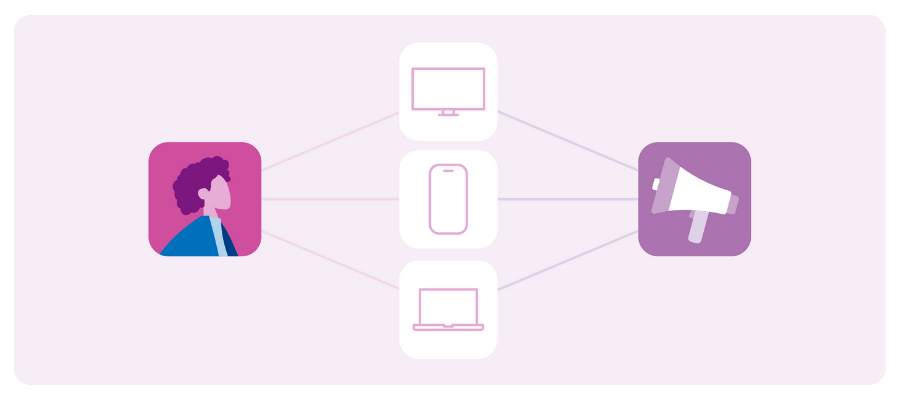At A Glance
Reaching the right audience is becoming more challenging as digital advertising grows increasingly fragmented, and privacy regulations change. 33Across addresses this by providing real-time intent signals and contextual insights, helping marketers connect with consumers across devices like CTV, mobile, and desktop. Integration into Experian's marketplace makes these solutions more accessible, helping advertisers achieve measurable results.In our Ask the Expert Series, we interview leaders from our partner organizations who are helping lead their brands to new heights in AdTech. Today’s interview is with Allison Dewey (Director, Data & Curation) at 33Across.
Navigating complexity in digital advertising
Digital advertising is more fragmented and privacy-constrained than ever. How is 33Across helping marketers cut through that complexity to drive real outcomes, and what makes your approach distinct?
Reaching audiences without compromising scale or performance is one of the toughest challenges for marketers. Users consume content across multiple devices and channels, making it difficult for marketers to identify and accurately target them with the right message. 33Across segments leverage AI-powered contextual and behavioral signals across privacy-safe environments to help marketers accurately identify audiences, whether they’re streaming content on their connected TV or researching products on their mobile device. What sets us apart is that we don’t just identify valuable audiences; we help marketers also target cookieless inventory and power it with real-time signals.

Marketplace integration milestones
What excites you most about bringing 33Across audiences into Experian’s data marketplace?
We’re excited to bring 33Across audiences into Experian’s data marketplace because it connects our unique segments with a powerful data ecosystem that marketers already trust. Buyers looking to activate audiences that are both privacy-safe and performant continue to tap into the Experian data marketplace for high-quality, high-performing data. We offer a wide range of audience verticals, including B2B, demographic, retail purchase data, interest and intent, and political data. In addition, we offer the ability to create custom segments across verticals.

Our intent-based audiences, built from contextual and engagement signals, help buyers reach consumers on CTV, desktop, or mobile devices with scale. Being part of Experian’s data marketplace accelerates access to these audiences, drives better ROI, and helps brands future-proof their strategies today.

Retail demand signals
Retail brands are racing toward privacy-safe, first-party data. Which 33Across retail datasets or segments are experiencing the highest demand, and what makes them a must-have?
Retail marketers are leaning into contextual and behavioral intent signals to complement their first-party data strategies. At 33Across, we’re seeing high demand for segments tied to shopping intent, including in-market consumers browsing for categories like fashion, home goods, electronics, and health & wellness.
What makes these segments essential is their real-time nature – they can capture consumer interest as it happens. For retail brands looking to expand their reach while respecting privacy, our segments offer scalable, actionable intent that drives results.

B2B without cookies
Reaching real B2B decision-makers at scale is tough with or without signals. How does 33Across deliver both precision and reach in this environment?
B2B marketing often struggles with balancing scale and specificity. 33Across addresses this by combining contextual precision with AI-modeled behavioral signals; this segment approach reaches professionals actively engaging with relevant content and topics, even in environments where IDs are unavailable. Marketers gain access to more signals and, in turn, better reach from 33Across’ unique publisher integrations and audience curation built from machine learning and AI.
We surface intent through content consumption patterns and contextual engagement, unlocking valuable, privacy-safe signals at scale. Allowing B2B marketers to reach real decision-makers in a signal-sparse world.

Use cases
With retail, B2B, and beyond, can you share an example of how brands in these verticals are utilizing your audiences?
Top brands that have a user-focused approach use 33Across audiences to drive scale; performance. These brands enable our segments to precisely reach the right users across devices and increase conversion rates; brand awareness. By reaching the right users, brands have higher conversion rates and increase campaign efficiency.

Supply path innovation
As identifiers disappear, advertisers are looking for scalable, privacy-safe ways to reach real people. How is 33Across helping unlock more addressable inventory and drive performance?
By combining contextual, semantic, and engagement-based signals, we deliver intent-based targeting that performs across CTV, display and video. Higher addressability helps marketers not only extend their reach but also deliver personalized messaging across digital channels in a privacy-compliant way.
Contact us
About our expert

Allison Dewey
Director of Data and Curation, 33Across
Allison Dewey is the Director of Data & Curation at 33Across, where she oversees data partnerships, integrations, and supply-side curation. With a deep expertise in audience targeting and signal optimization, Allison plays a key role in connecting data into the programmatic world. Allison holds a Bachelor’s degree in Psychology from Bates College.

About 33Across
Rooted in over 15 years of data expertise, 33Across harnesses signals to enrich and expand marketers’ audiences and reach them wherever they consume content. Built from over 300 billion proprietary data signals, we apply machine learning and AI to create over 1,500 B2C and B2B segments using privacy-first principles to reach audiences.
Cookieless targeting FAQs
By using contextual and engagement-based signals, advertisers can target consumers across CTV, mobile, and desktop in a privacy compliant way, even as identifiers become less available.
Segments tied to shopping intent, such as consumers browsing fashion, electronics, or health products, are highly sought after because they capture real time interest and drive results.
Combining content engagement patterns with machine learning allows marketers to reach professionals actively engaging with relevant topics, even in environments where IDs are unavailable.
Privacy safe targeting uses real time contextual and behavioral signals to deliver relevant messaging across devices and channels without compromising consumer trust.
Real time intent signals allow advertisers to capture consumer interest as it happens, helping demand side platforms and brands deliver timely, relevant ads that increase engagement and drive conversions across devices like CTV, mobile, and desktop.
Latest posts

Strong Revenue Performance and Thriving Culture Contribute to Industry Recognition NEW YORK, Sept. 15, 2016 /PRNewswire/ — Tapad, the leader in cross-device marketing technology and now a part of Experian, was named a top company on Inc. Magazine’s list of the 5000 fastest-growing private companies in the U.S. In addition, Tapad won the TMCnet 2016 Tech Culture Award. The exclusive Inc. 5000 ranking highlights the fastest-growing privately-held* companies in America. These distinguished companies have achieved success in strategy, service and innovation. TMCnet recognizes talented tech professionals who are committed to building a culture that prioritizes employee growth, collaboration and engagement. Tapad continues to broaden their presence into new markets, having launched in APAC earlier this year, as well as continuing their European expansion. Tapad’s proprietary technology, The Device Graph™ is leveraged by more marketers and brands to understand digital engagement across devices. The company’s rapidly expanding client base includes numerous Fortune 500 company brands as well as all four major advertising holding companies in the U.S. “We have an exceptional team of innovative people who are all working very hard to achieve the kind of results these publications are recognizing,” said Tapad CEO and Founder, Are Traasdahl. “Given that, we have an even greater responsibility to our talent to create an environment that fosters innovation and nurtures open communication. Ultimately, this is how we will continue to reach our very ambitious goals of becoming the world’s leading unified marketing technology provider.” Tapad’s award-winning work culture is defined by its gold-standard benefits which include a six-month parental leave policy, unlimited vacation time, company-sponsored meals and office space designed to facilitate collaboration and open communication. Tapad’s highly talented team has also received multiple customer service awards in 2016. These awards include the iMedia ASPY awards for Best Customer Service and Best Mobile Partner as well as recognition from The Communicator Awards of Excellence in Interactive Media. *Prior to Tapad’s acquisition by Telenor in February 2016. Contact us today

The Tapad Device GraphTM Had Twice the Precision and Three Times the Scale as Next Competitor New York, September 14, 2016 – Just-released findings of a Hotels.com® study revealed that Tapad’s (part of Experian) cross-screen marketing technology achieved the highest levels of precision and scale among competitors. According to the leading online accommodation booking website, after a rigorous, three-and-a-half month vendor analysis, Tapad achieved twice the precision of the next highest-scoring cross-screen offering and three times greater scale. The two other companies evaluated were not named. Said Helene Cameron-Heslop, Senior Manager of Analytics of the Hotels.com brand, “Our team implemented an extremely rigorous vetting of open, cross-screen technology vendors. At the outset, we assumed we would have to compromise on either scale or accuracy – particularly given the importance to our brand of operating in a privacy-safe setting. We were surprised to find a complete package, but Tapad’s Device Graph won out on scale, accuracy and privacy; making our choice of partners very clear.” In another metric critical to the Hotels.com brand, The Tapad Device GraphTM was eight times more “unique” than the next closest offering, meaning Tapad’s graph was found to have a much greater number of connections not seen in any of the other graphs. In addition to precision, uniqueness and scale, the Tapad Device GraphTM was found to have: ● 100% higher recall● 47% more incremental matches● 53% higher North American market coverage● 101% higher F-Score* “A valuable cross-device solution should enable partners to get everything they’re looking for from a single vendor,” said Tapad Founder and CEO, Are Traasdahl. “We are deeply impressed with how thorough Hotels.com was in their vetting, and we confidently tackle the complex challenges of the martech industry thanks to our superior technology. Everyone loves a bake-off, and Tapad is no exception – delivering best-in-class results in areas that really count.” *F-score is a statistical measurement that takes precision and recall together. The calculation is 2*(precision*recall)/precision + recall). It gives you one number instead of two numbers to look at and judge performance. Contact us today

Five Norwegian startups selected to establish U.S. presence NEW YORK, Aug. 15, 2016 /PRNewswire/ — Tapad, the leader in cross-device marketing technology and now a part of Experian, has announced its new entrepreneurial mentorship initiative, the Propeller Program. Five early-stage startups from Norway have been chosen by Are Traasdahl, native of Norway and Tapad’s CEO and founder. The selected companies will share Tapad’s New York City workspace, receive C-level guidance and help establish a U.S. presence. The following companies have been selected to participate in the inaugural Propeller Program – a 12-month program beginning September 19, 2016: Bubbly – Developers of a platform that enables in-store customer feedback with dashboards and tools that facilitate real-time store response BylineMe – A marketplace for freelancers, publishers and brands to connect for content creation and distribution services Eventum – A property-sharing group that digitally assists in securing venues for meetings and corporate events Xeneta – A database that organizes the best contracted freight rates in real time and on demand “We are supporting startups that we feel represent the future of service offerings,” said Traasdahl. “It is with incredible pride that we invite these entrepreneurial teams from Norway to join us in New York Citythis year. Mentorship opportunities for early-stage companies are so important, particularly for those based outside the U.S. I look forward to giving the Propeller Program participants access to the expertise of my seasoned team and to our wide network of resources. Hopefully, it will be a game-changing year for many of them.” Contact us today